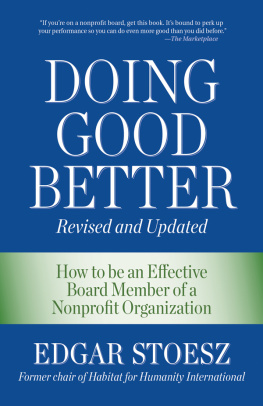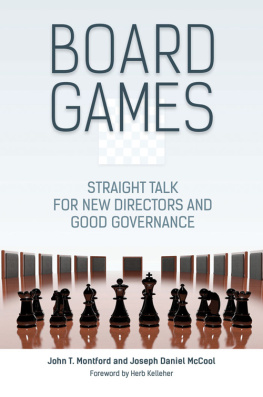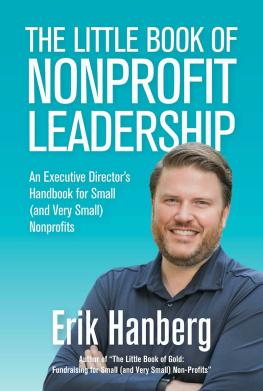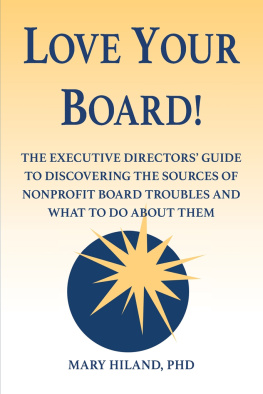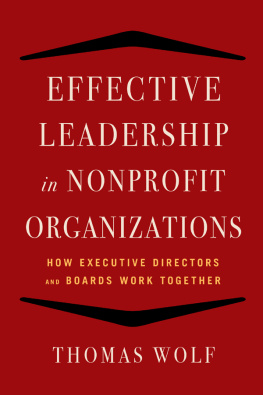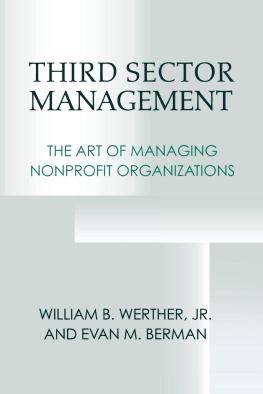Dedicated to the memory of
W ILLIAM T. S NYDER
Mennonite Central Committee
Executive Secretary
19571985
Servant leader
Mentor
Friend
Acknowledgments
Some writers acknowledge their publishers out of a sense of obligation. I acknowledge Good Books with a deep sense of deserved appreciation: Merle for insisting on presenting the book in an accessible manner; Phyllis for her excellent editing so that readers understand what I mean; Kate for helping the book find its audience; Cliff for designing the pages so clearly.
I also acknowledge the many who interacted with me on this important subject, either in response to one of my earlier books or in one of my workshops, or who served with me in some capacity. This books grows out of my interaction with many colleagues who like myself are striving to do good even better. From a long list I will name just two: Chester Raber with whom I co-authored Doing Good Better and long-time friend and Rick Stiffney who read the manuscript and offered helpful suggestions.
Copyright 2014 by Edgar Stoesz
All rights reserved. No part of this book may be reproduced in any manner without the express written consent of the publisher, except in the case of brief excerpts in critical reviews or articles. All inquiries should be addressed to Good Books, 307 West 36th Street, 11th Floor, New York, NY 10018.
Good Books books may be purchased in bulk at special discounts for sales promotion, corporate gifts, fund-raising, or educational purposes. Special editions can also be created to specifications. For details, contact the Special Sales Department, Good Books, 307 West 36th Street, 11th Floor, New York, NY 10018 or info@skyhorsepublishing.com.
Good Books in an imprint of Skyhorse Publishing, Inc., a Delaware corporation.
Visit our website at www.goodbooks.com.
10 9 8 7 6 5 4 3 2 1
Library of Congress Cataloging-in-Publication Data is available on file.
Drawing on by Cheryl Benner
Design by Cliff Snyder
Print ISBN: 978-1-56148-601-4
Ebook ISBN: 978-1-68099-001-0
Printed in the United States of America
Library of Congress Cataloging-in-Publication Data
Stoesz, Edgar.
Doing good even better : how to be an effective board member of a nonprofit organization / Edgar Stoesz.
p. cm.
ISBN-13: 978-1-56148-601-4 (alk. paper) 1. Nonprofit organizations--Management. 2. Directors of corporations. I. Title.
HD62.6.S76 2007
Table of Contents
Preface
I n 1994 I wrote Doing Good Better with my friend, Dr. Chester Raber. In 2000 I wrote Common Sense for Board Members . In Doing Good Even Better: How to be an Effective Board Member of a Nonprofit Organization I have brought the best of those earlier books together, and Ive added what I have learned along the way since then.
Doing Good Even Better gives directors technical and tactical suggestions to increase their board-service effectiveness. I believe that ones attitude is as important as ones actions. Serving on a nonprofit board is:
DutyTo whom much has been given, much shall be required. It is a privilege to help others.
SpontaneousAct as the spirit moves, and also with planning and practicing.
An art formLike playing jazz, as well as operating by the formulas that work.
Idealistic, and down-to-earth practical.
Giving and receiving in the spirit of St. Francis of Assisi who said, It is in giving that we receive.
Dead serious, and fun, most of the time.
One more thing. I am frequently asked, Do your suggestions and strategies for serving on a nonprofit board also apply to working in ones local church? Many nonprofit leaders are also congregational leaders, and most local churches face governance issues. Doing Good Even Better is directed to nonprofit organizations. On the other hand, much of what I say here also applies to congregationswith some adaptations.
Never think someone is losing time by stopping to sharpen his axe.
Abraham Lincoln
PART I
Doing Good Even Better Begins with People
N onprofit organizations are about people. People own themfor a purpose. People, with all their gifts and foibles, run them. Organizations do not run themselves. They are not run by something mysterious or extraterrestrial. Organizations are people work.
It follows logically that organizations are only as great as the people who are involved in them. They depend upon the synergy that results from the interaction of people who are reasonably of the same mind.
Remember that directors serve in a fiduciary capacity. They do not own; they hold in trust. The tangible and intangible assets of the organization are entrusted to the board for one purposeto fulfill the purpose for which the organization exists.
Part I begins, therefore, by focusing on people who should serve on a nonprofit board. I follow that by addressing how they should do their work, through program and procedures.
Apart from people, an organization is only a shell. It knows nothing. It can do nothing. What an organization is capable of doing resides in the abilities of the people who run it.
CHAPTER 1
Organizational Greatness Begins with People
I n his highly acclaimed book Good to Great, Jim Collins suggests that the formula for organizational greatness is A.) getting the right persons on the bus, B.) getting the wrong persons off the bus, and C.) positioning them on the bus for maximum effectiveness. A clear, if not an easy, formula to achieve.
Would-be members of a great board must meet a three-fold test:
Personal qualifications
Is the potential director compatible with the organizations values and culture? Has s/he demonstrated genuine interest in its cause or similar causes? Is s/he self-aware and at peace with her-/himself and able to participate constructively in a group process while retaining independence of thought? Is her/his lifestyle in harmony with the organization?
Beware of someone who brings her/his own agenda, who is interested in the task for all the wrong reasons. Beware of Lone Ranger directors. Board work is a team sport.
Proven competencies
What does the potential director know? What is s/he capable of doing? Do the demonstrated competencies of the board members encompass the entirety of the boards tasks?
Apart from people, an organization is only a shell. It knows nothing. It can do nothing. What an organization is capable of doing resides in the abilities of the people who run it. Some skills can be hired in, but a board must have in its ranks persons who understand the big picture well enough to give direction to the total effort. Directorship is first and foremost about mature insight and proven judgment, and only secondarily about honors or prestige.
Representative
Does the prospective director represent the membership? A good nonprofit board has a mix of women and men, young and old, ethnicities, and the professions. Avoid being another old-boys club made up of gray-haired, white Protestant males. When your members review their board roster they should say, They represent me. I have confidence in them. This is especially important for nonprofits whose primary support comes from public appeals.
These three dimensions must be balanced according to the present circumstances when a board vacancy occurs. The need for a treasurer, for example, may be so urgent that other qualifications are put into secondary importance, but the ideal is always a board with a balanced representation of these three qualifications.


